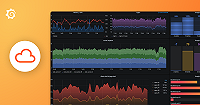Important: This documentation is about an older version. It's relevant only to the release noted, many of the features and functions have been updated or replaced. Please view the current version.
Python
The Python profiler, when integrated with Pyroscope, transforms the way you analyze and optimize Python applications. This combination provides unparalleled real-time insights into your Python codebase, allowing for precise identification of performance issues It’s an essential tool for Python developers focused on enhancing code efficiency and application speed.
Note
Refer to Available profiling types for a list of profile types supported by each language.
Before you begin
To capture and analyze profiling data, you need either a hosted Pyroscope OSS server or a hosted Pyroscope instance with Grafana Cloud Profiles (requires a free Grafana Cloud account).
The Pyroscope server can be a local server for development or a remote server for production use.
Add Python profiling to your application
Install the pyroscope-io pip package:
pip install pyroscope-ioConfigure the Python client
Add the following code to your application. This code will initialize the Pyroscope profiler and start profiling:
import pyroscope
pyroscope.configure(
application_name = "my.python.app", # replace this with some name for your application
server_address = "http://my-pyroscope-server:4040", # replace this with the address of your Pyroscope server
)Optionally, you can configure several additional parameters:
import pyroscope
pyroscope.configure(
application_name = "my.python.app", # replace this with some name for your application
server_address = "http://my-pyroscope-server:4040", # replace this with the address of your Pyroscope server
sample_rate = 100, # default is 100
detect_subprocesses = False, # detect subprocesses started by the main process; default is False
oncpu = True, # report cpu time only; default is True
gil_only = True, # only include traces for threads that are holding on to the Global Interpreter Lock; default is True
enable_logging = True, # does enable logging facility; default is False
tags = {
"region": '{os.getenv("REGION")}',
}
)Add profiling labels to Python applications
You can add tags to certain parts of your code:
# You can use a wrapper:
with pyroscope.tag_wrapper({ "controller": "slow_controller_i_want_to_profile" }):
slow_code()Sending data to Pyroscope OSS or Grafana Cloud Profiles with Python SDK
import pyroscope
pyroscope.configure(
application_name = "example.python.app",
server_address = "<URL>",
basic_auth_username = '<User>',
basic_auth_password = '<Password>',
# Optional Pyroscope tenant ID (only needed if using multi-tenancy). Not needed for Grafana Cloud.
# tenant_id = "<TenantID>",
)To configure the Python SDK to send data to Pyroscope, replace the <URL> placeholder with the appropriate server URL. This could be the Grafana Cloud URL or your own custom Pyroscope server URL.
If you need to send data to Grafana Cloud, you’ll have to configure HTTP Basic authentication. Replace <User> with your Grafana Cloud stack user and <Password> with your Grafana Cloud API key.
If your Pyroscope server has multi-tenancy enabled, you’ll need to configure a tenant ID. Replace <TenantID> with your Pyroscope tenant ID.
Python profiling examples
Check out the following resources to learn more about Python profiling:
- Python examples
- Python demo showing Python example with tags


